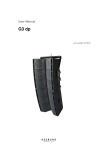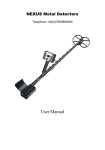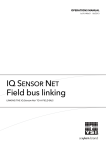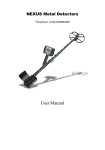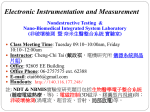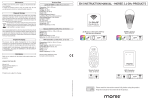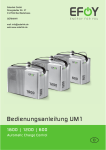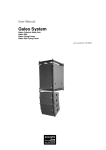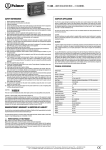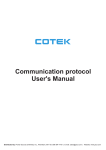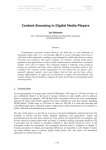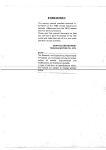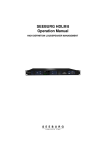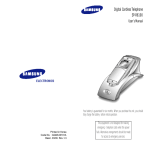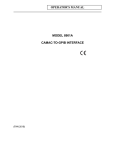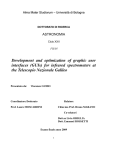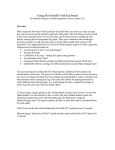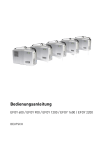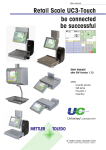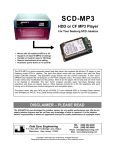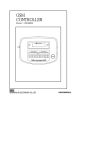Download User Manual - SEEBURG acoustic line
Transcript
SEEBURG acoustic line active systempanel 2.5 User Manual Oktober 2003 TABLE OF CONTENT 1 INTRODUCTION 1.1 Using This Manual 1 2 2 CONTROLS AND CONNECTIONS 2 3 THE SP2.5 FUNCTIONS 5 3.1 Active Crossover 3.1.1 Setting the crossover frequency 3.1.2 Phase correction 3.1.3 High-Mid attenuation 3.1.4 Fullrange mode 3.2 Limiter 6 3.3 Subsonic and Ultrasonic Filter 7 3.4 Equalizer 3.4.1 Setting the Filterwidth 3.4.2 Bassboost 8 8 9 4 APPENDIX 10 4.1 Tabels 11 4.2 Note - Chart for SP2.5 - Configurations 12 4.3 Factory Settings 13 4.4 Technical Specifications SP2.5 13 4.5 Glossary 14 SEEBURG acoustic line 1 SP2.5 User Manual Page 1 Introduction Congratulations! With the SEEBURG acoustic line SP2.5 you have purchased a versatile and professional controller for touring and installed applications. It´s flexible possibilities make the SP2.5 suitable and compatable for existing PA Systems. Operating in analog technology, it uses only highest grade components and garantees a very natural and first-class sound reproduction. Please read this manual carefully to allow your system to achieve it’s full potential. Keep this manual for further reference. The SP2.5 is used as a link between amplifiers and loudspeakers (Fig.1). It combines an active 2way stereo crossover, system Controller and a I/O connection panel in a standard 19" housing using only one rack space (1U). Amp.HighMid MischMixing Desk pult Amp. Sub Am p. Bass fig 1 connection diagram SP2.5 SEEBURG acoustic line SP2.5 Manual Page 2 Schaltbar von Frontplatte Subsonic Bassboost Ultrasonic ST4 EQ1 Unsymm. 35Hz 18dB Tiefpass 20kHz 18dB C12 C13 + 6dB 40-80Hz 100Hz 2,2kHz Phase Limiter ST5 Über Senseleitung Phase Gain 180° ST7 EQ2 Symmetrierung 480Hz 11kHz Hochpass R68 EQ3 Fullrange Schaltbar von Frontplatte dito Hochpass Tiefpass Phase R117 R120 P4 Gain P5 0dB bis -13dB C43 C44 Über Senseleitung Symmetrierung Limiter Sub out Symmetrierung fig 1 block diagram SP2.5 If ordered together with a SEEBURG acoustic line system the SP2.5 will be delivered with settings for the specific system. For allround applications the 2.5 will be delivered with a STD factory setting (see appendix, 4.3). To make changes in the configuration the unit must be opened, SIPs (resistor arrays) or jumpers must be changed. In doubt please contact your SEEBURG acoustic line dealer. Important: The unit must be shut off, mains should be unplugged. The manufacterer will not be held responsible for any problems due to unortherized handling! 1.1 Using this manual We will briefly describe the teminology used to help you understand the unit and it´s functions. Since we cannot explain all technical terms regarding electroacoustics we have provided a glossary in the appendix. In case you come about any questions or problems while setting up your SP 2.5, please contact you SEEBURG acoustic line dealer. 2 Controls and connections of the SP2.5 You will find the following controls on the front panel of the SP2.5: • Power on-LED: Signals the presence of Mains (plugged in and switched on). • Audio in Channel A and B: Indicates presence of input singnal (from Mix) for Channel A and B. • Link to next panel Channel A and B: Parallel link out of the unprocessed input signal, i.e. to other SP2.5 units or Amplifiers. • Signal A/B-LED: Indicates the presence of an input signal with a level over -20dB. • Bass boost : The additional bass boost (+6dB @ 55Hz) is switchable at the front panel. The LED next to the switch will light up if active. • Fullrange (mounted decreased to prevent accidential switching): This switch changes the highmid output to Fullrange mode. The according LED will light up if active. • Limit-LEDs for woofer and high-mid: The four LEDs will light up if limiters are active. SEEBURG acoustic line SP2.5 Manual Page 3 • output to speakers: Speakon connectors for speaker connection. Pins 1+/- carry the high-mid signal, Pins 2+/- the bass signal. Rear panel connectors on the of the SP2: • Amp Return woofer and high-mid: Speakon connectors (coding: 1+/-=A; 2+/-=B) for connecting amplifier outputs to the SP2.5 inputs. Please check for correct polarity. (NL4FC is 1:1) • Signal to Amp sockets for high-mid A/B and woofer (bass) A/B: Connectors for connecting the outputs of the SP2.5 to the corresponding amplifier inputs. • Sub out (mono): This connector carries a additional bass mono signal which can be adjusted in phase & level using the controls PHASE & LEVEL. SEEBURG acoustic line SP2.5 Manual fig 2 Front panel connectors and controls Page 4 fig 3 Rear panel connectors and controls SEEBURG acoustic line 3 SP2.5 Manual Page 5 SP2.5 Functions 3.1 Active Crossover The integrated 2-way crossover divides the audio spectrum into passbands for each transducer and distributes the preamplified signal from the mixer to the corresponding amp channels for bass, mid & high frequencies. The crossover frequencies are set using risistor arrays (SIPs). The bass band is limited by an highpass filter, the hi-mid band is limited by an lowpass Filter, both typs are Butterworth with 24dB/octave slopes. The following parameters can be edited: 3.1.1 Cutoff frequency By using different resistor values (SIPs) the crossovers cutoff frequencies can be set, also allowing the bands to overlap. The resistor values are listed in the appendix in table 1. 3.1.2 Phase correction Difference in phase between the two bands can be adjusted by altering the phase of the bass band (0° to 180°, lightgreen jumper in positions 0. 35, 70, 105, 140 or 180). The phase of the hi-mid band can be reversed by 180°. To do this set the corresp onding lightgreen jumper to position 180. This phase correction can be usefull in case the acoustic centres of two loudspekers radiating the same frequency are horizontally not in plane (transducer alignment). This geometrical distance lets the acoustic energy radiated by the closer loudspeaker arrive the listeners ear earlier due to the 1 shorter distance it has to travel, resulting in unwanted interference at that particular frequency. fig 4 phase correction 1 see glossary / appendix SEEBURG acoustic line SP2.5 Manual Page 6 The amount of phase correction (Φ in degrees) you need at a given distance between loudspeakers (∆s) is calculated as follows: Φ= ∆s ⋅ 360°⋅ f c φ: Phase angle in degrees ∆s: Distance between the loudspeakers in meters c: Speed of sound (in air at 101,3 hPa and 20 οC approximatly 340 m/s; c increases/decreases approximatly 0,6m/s every 1° Celsius) Example: A wedge with two 12“ and one 2“ drivers needs to be setup using the SP2.5 in two-way active configuration. The acoustic centre of the 2” driver is 11,5 cm behind the center of the 12” drivers. The crossover cutoff frequency is 1500 Hz. The amount of phase correction for the 11,5cm in this example is: Φ= 0,115m ⋅ 360°⋅1500 1s 340 ms = 182,64° ≈ 180° 3.1.3 High-Mid Attenuation The high-mid attenuator allows the high-mid band to be attenuated in 2,5dB steps in relation to the bass band, i.e. if the bass driver has a lower efficiancy than the high-mid driver. This is done by setting the red jumper on the circuit board to the desired position. The amount of attenuation is listed next to the socket (fig.5). The first position marked “0” provides no attenuation, or 0 dB. fig 5 Jumper socket for the attenuation in the mid-high band 3.1.4 Full range mode (high-mid band) Depressing the (decreased mounted) full range switch on the front panel bypasses the highpass of the crossover. This allows fullrange capable mid-high systems to be operated over the complete bandwidth. This full range mode is indecated by the corresponding LED lighting up. 3.2 Limiter The SP2.5 includes four limiters (high-mid CH. A und CH. B, Bass CH. A und CH. B). attack/release can be individually adjusted for each limiter in three steps, the amount of power transmitted to the transducers can also be set here. SEEBURG acoustic line SP2.5 Manual Page 7 To insure correct limiter function it is important to connect the speakers using the two speakon connectors (“speaker out”) on the front panel. The amplifier outputs are connected via “amp return” connectors on the back panel of the SP2.5. By feeding the amplifiers output signal through the SP2.5, it is possible to exactly measure the amount of power fed to the speaker drivers. This measurement with internal sensing is a must for acurate limiter operation (see fig.1). Time related limiter settings are made via blue jumpers in the limiter section of the circutboard. The jumper sockets are labeld fast (A), medium (B) and slow (C): Time settings for bass- & high-mid are: Bass: HighMid: A = 20ms, A = 10ms, B = 100ms, B = 40 ms, C = 200ms C = 100ms The maximal power values for each limiter are set with four 5-way DIP switches. Positions for power and impedance are listed in table 2 in the appendix. Red LEDs on the front panel indicate limiter action. The SP2.5 limiter has a dynamic characteristic, which means the power is not totally 2 limited immediately when threshold is reached, the compression ratio rises as amp power does (fig.6). fig 6 principle limiter charactertistic. The LED will light at point A. The compression ratio then rises as input signal does (range between point A & point B). The maximum compression ratio of approximately 1:20 is reached after the input signal reaches point B. 3.3 Subsonic and ultrasonic filter The subsonic-filter is a highpass filter with an edge steepness of 18 dB/oct, the ultrasonic filter a lowpass with the same edge steepness. The –3dB cutoff frequency are at 35Hz and 20kHz. The idea is to damp frequencies outside of the relevant audible range (infra- and ultrasonic). These filters are always active and cannot be turned off. 2 see glossary / appendix SEEBURG acoustic line SP2.5 Manual Page 8 3.4 Equalizer funktion The SP2.5 offers two fully parametric EQs and one semi parametric EQ (fixed Q) on every channel. Adjustments are made via the corresponding trimmpots on the circuit board (fig 8 and fig 9). A maximum cut/boost of +/- 12 db is available. Please try to avoid cutting or boosting too extremely. In order to activate the circuts the black jumper must be inserted to the corresponding postions marked “EQ-INSERT”. To deactivate the circuit insert the jumper to a position marked “bypass” EQ1 and EQ2 have different ranges to set the cutoff frequencies. These frequencies are set by inserting different values of SIPs (resistor arrays, all E12 plus 20 kΩ from E24). The frequency ranges and resistor values for the SIPs are listed in table 1 in the appendix. The sockets for frequency selection (SIPs on the circuit board) are marked “FREQUENCY” fig 8 mesuered frequency curves EQ1 (Q=12) SEEBURG acoustic line SP2.5 Manual Page 9 fig 9 mesuered frequency curves EQ2 (Q=12) fig 8 and fig 9 show a decrease of the zero lines under 50Hz and obove 15kHz. This effect results of the SP2.5´s built in subsonic and ultrasonic filters (see 3.3). 3.4.1 Adjusting the EQ slope (Q-factor) 3 The slope of the EQ filter (Q-Faktor ) can be adjusted by setting the yellow jumper on the circuit board, the socket ist marked “bandwidth“. The three available types (fig 10) are: • Peak (Q = 12): yellow jumper left position • Normal (Q = 3): yellow jumper middle position • Shelve (Q = 1,5): yellow jumper right position The fourth position (far right) can be used for further optional slopes to be custom designed. Resistor R26 and/or R46 must be soldered: Please contact your SEEBURG acoustic line service. 3 see glossary / appendix SEEBURG acoustic line SP2.5 Manual Page 10 fig 10 the three mesured filter slopes 3.4.2 Bass boost Pressing the bass boost switch on the front panel activates a 6dB boost @ 55Hz. The corresponding LED indicates active boost. SEEBURG acoustic line 4 SP2.5 Manual Page 11 Appendix 4.1 Tables resistor array 220 330 390 470 560 680 820 1K 1K2 1K5 1K8 2K2 2K7 3K3 3K9 4K7 5K6 6K8 8K2 10K 12K 15K 18K 22K frequency x-over 4K7 3K8 3K2 2K7 2K3 1K8 1K5 1K3 1K 820 680 550 450 380 315 270 220 175 145 120 92 78 60 frequency: EQ1 2K1 2K 1K8 1K7 1K6 1K5 1K3 1K2 1K1 920 800 700 600 510 440 380 320 270 225 185 150 130 110 frequency: EQ2 11K 9K2 9K 8K3 7K9 7K1 6K7 6K 5K3 4K7 4K1 3K7 3K1 2K8 2K3 2K 1K7 1K45 1K25 1K 850 700 580 490 table 1 SIP resistor values for setting cutoff frequencies and EQs resistor values in Ohm (Ω). frequency in Hertz (Hz). These values noted in three numbers: The first and second show the resitor value, the third shows the numbers of zeros to be added: Example: 222: 2200 Ω = 2,2 kΩ 153: 15000 Ω = 15 kΩ SEEBURG acoustic line SP2.5 Manual Page 12 Threshold Schwelle Switch Schalterstellung S1 S5 U P 16 P8 P4 P2 OFF OFF OFF OFF OFF 12 9 18 36 72 ON OFF OFF OFF OFF 15 14 28 56 113 OFF ON OFF OFF OFF 18 20 41 81 162 ON OFF OFF OFF 21 28 55 110 221 OFF OFF ON OFF OFF 24 36 72 144 288 ON OFF ON OFF OFF 28 49 98 196 392 OFF ON ON OFF OFF 32 64 128 256 512 ON ON OFF OFF 36 81 162 324 648 OFF OFF OFF ON OFF 40 100 200 400 800 ON OFF OFF ON OFF 44 121 242 484 968 ON 48 144 288 576 1152 ON S2 ON S3 S4 ON OFF ON OFF OFF OFF ON ON OFF 52 169 338 676 1352 ON OFF ON ON OFF 56 196 392 784 1568 OFF ON ON ON OFF 60 225 450 900 1800 ON ON ON OFF 64 256 512 1024 2048 OFF OFF OFF OFF ON 68 289 578 1156 2312 ON OFF OFF OFF ON 72 324 648 1296 2592 OFF ON OFF OFF ON 76 361 722 1444 2888 ON ON OFF OFF ON 80 400 800 1600 3200 OFF OFF ON OFF ON 84 441 882 1764 3528 ON OFF ON OFF ON 88 484 968 1936 3872 OFF ON ON OFF ON 92 529 1058 2116 4232 ON ON OFF ON 96 576 1152 2304 4608 ON ON OFF OFF OFF ON ON 100 625 1250 2500 5000 ON OFF OFF ON ON 104 676 1352 2704 5408 OFF ON OFF ON ON 108 729 1458 2916 5832 ON ON 112 784 1568 3136 6272 ON OFF ON OFF OFF ON ON ON 116 841 1682 3364 6728 ON OFF ON ON ON 120 900 1800 3600 7200 OFF ON ON ON ON 124 961 1922 3844 7688 ON ON ON ON 128 1024 2048 4096 8192 ON table 2 DIP-switch settings for limiter levels U P 16 P8 P4 P2 in Volt in Watt at 16 Ω impedance in Watt at 8 Ω impedance in Watt at 4 Ω impedance in Watt at 2 Ω impedance 3 On On 4 5 On On Fast OO Medium OO Slow OO Attack/Release for Limiter Treshold 1 On 2 3 On On 4 5 On On Attack/Release for Limiter 1 On 2 3 On On 4 5 On On Fast OO Medium OO Slow OO Attack/Release for Limiter Treshold High B Low B Channel B O Bandwith EQ1 Centerfrequency OOOO OOOO Valid: 480-11000 Hz OOOOOOOO Bandwith EQ2 Centerfrequency High A Atenuat. Crossover Low B OOOOOO OOOOOO Frequency Frequency OOOOOO OOOOOO OOOOOO OOOOOO OO 0° OO 180° 0 -2,5 -5 -7,5 -10 -13 0° 35° 70° 100° 140° 180° Low Phase B Phase for High B OO 0° OO 180° OOOOOOOO Low Phase A Phase for High A EQ3 OOOOOOOO 0° 35° 70° 100° 140° 180° Channel B OOOOOOOO OOOOOOOO Crossover Low A Channel A Frequency Bandwith EQ2 Centerfrequency Valid: 100-2200Hz OOOOOOOO EQ3 OOOOOO OOOOOO OOOO OOOO Crossover High A Valid: 480-11000 Hz OOOOOOOO Gain EQ2 + /- 12dB Crossover High A OOOO OOOO O Gain EQ1 + /- 12dB Frequency Gain EQ2 + /- 12dB Bandwith EQ1 Centerfrequency On On Treshold Low A O Valid: 100-2200Hz OOOOOOOO 4 5 Fast OO Medium OO Slow OO SP2.5 Manual OOOO OOOO 3 On On Attack/Release for Limiter Channel A Gain EQ1 + /- 12dB On 2 Treshold High A O 1 Fast OO Medium OO Slow OO SEEBURG acoustic line On 2 4.2 Note - Chart for SP2.5-configurations fig 11 note chart to archive controller-settings 1 0 -2,5 -5 -7,5 -10 -13 High B Atenuat. Page 13 SEEBURG acoustic line SP2.5 Manual Page 14 4.3 Factory Settings If your SP2.5 was not ordered for a specific SEEBURG acoustic line system, it will be delivered with the following standard preset: Cutoff frequency (SIP): 120 Hz (12 kΩ) Phase HighMid and Woofer: 0° Attenuation HighMid: 0 dB Center-frequency (SIP): 440 Hz (4,7 kΩ) Bandwidth: Normal (mid position) Gain: 0 dB (mid position) Center-frequency (SIP): 2 kHz (4,7 kΩ) Bandwidth: Normal (mid position) EQ 3 Center-frequency: 2500 Hz, Q = 1 (fixed) Limiter: All limiters are set to transmit a power of 400W to a 8 Ohm transducer. Crossover: EQ 1: EQ 2: 4.4 Technical Specifications SP2.5 Signal-To-Noise-Ratio (@ 6 dB): > 103 dB Total Harmonic Distortion (THD) (@ 6 dB): < 0,04 % Maximum Input Level (Headroom): 22 dBU Subsonic/Ultrasonicfilter: -3 dB points @ 35 Hz and 20 kHz -18 dB/octave slopes Output impedance (Signal to Amp): 600 Ω Input impedance (Audio In): 40 kΩ Mains: 230 Volt/AC/10 VA Dimensions (W x H x D): 482 x 440 x 230 mm Weight: 3,4 kg Equalizer function: cut/boost: ±12 dB Range EQ1: 110 - 2100 Hz EQ2: 490 - 11000 Hz EQ3: 2500 Hz Q = 1 In keeping with our policy of continued improvement, SEEBURG acoustic line reserves the right to alter specifications without prior notice. SEEBURG acoustic line SP2.5 Manual Page 15 4.5 Glossary • compression ratio: A compressor limits the level of an audio signal, as soon as it exceeds a certain adjustable value (threshold). Below the threshold the slope is 1 (a ratio of 1:1), which means output value is equal to input value. At the threshold the characteristic changes to a less steep slope, depending on the compression ratio. COMPRESSION RATIO determines the ratio of change on output signal to changes in input level for all signals that exceed the threshold. A limiter has a compression ratio of 1:∞, meaning no increase of output level no matter how much the input level increases (after exceeding the threshold level!). fig 12 compression ratio • Level (Dezibel, dB): In audio we have a to care a lot about levels. A level can mean a voltage or power and often a sound pressure in relation to a reference voltage, reference power or reference sound pressure. This scale used is logarithmetic, and the unit used is Bel, for matters of size mostly used is dezi-Bel, or short dB. For power level the definition is Lp P = 10 ⋅ log( ) dB P0 With a known impedance a level can also refer to a voltage: Lu U = 20 ⋅ log( ) dB U0 In our part of the audio world the reference voltage U0 is 0,775V. The reference power P0 is defined at 1mW, resulting in a voltage of 0,775 V over a 600 Ω resistor. SEEBURG acoustic line SP2.5 Manual Page 16 • Phase shift: If two waves with the same frequency and same zero crossing overlay (they are in phase), they will add to a new wave with exact doubled amplitude (fig 13a). If these waves are shifted by 180°, they will cancel each other ( fig 13b). The time shift between two waves is called phase shift. Depending on size of this phase shift, there will be more or less amplification or cancellation. This will also happen with two waves of different amplitudes, it will then not result in total cancellation at 180°. fig 13 two waves, same amplitude, frequency and phase (a)) add to a new wave with doubled amplitude • Q-factor: The Q-factor (or Q) ist the width of the slope produced by a filter circuit. Every EQ is a electronic filter (resonant circuit). A EQ with a small Q will alter neighbor frequencies of the cutoff frequency more than a EQ with a large Q. If you want to very perecisly alter one single frequency, you will need a very high Q. Sometimes you´ll want to effect a broader band, i.e. lower band of a complete P.A. system (50 to 150 Hz), in that case you need a filter with a low Q. For you slope freaks out there: The Q for electric resonant circuits is: Q= f0 B B Bandwidth: B = fa-fb (fa is the upper 3dB frequency, fb the lower) fo Resonance frequency: fo = √(fa x fb) SEEBURG acoustic line SP2.5 Manual Page 17 SEEBURG acoustic line GmbH Auweg 32 D-89250 Senden/Freudenegg www.seeburg.net



















